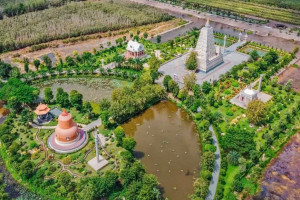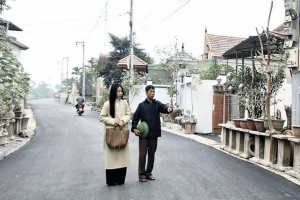
Khai ha – Cau an festival at Mandarin Lê Văn Duyệt’s mausoleum in Ho Chi Minh City proposed to be recognized as national intangible cultural heritage
07/10/2021
The People's Committee in Ho Chi Minh City has just sent a dispatch requesting the Ministry of Culture, Sports and Tourism to consider the Khai ha – Cau an festival of Mandarin Lê Văn Duyệt’s mausoleum recognized as a national intangible cultural heritage.
Mandarin Lê Văn Duyệt (1764 - 1832) lived under King Gia Long (1802 - 1820) and King Minh Mang (1820 - 1841), and had many merits in the cause of developing the southern land of the country, especially the Saigon - Gia Dinh area.
When he was still alive, Mandarin Lê Văn Duyệt guided local people to annually perform the Ha neu ceremony (bamboo tree down ceremony) aiming to pray for favorable weather in the locality.

Mandarin Lê Văn Duyệt’s tomb in Ho Chi Minh City’s Binh Thanh district
Mausoleum of Mandarin Lê Văn Duyệt, also known as Ong Ba Chieu mausoleum, with an area of 18,500 m2 located in Ho Chi Minh City’s Binh Thanh district, is the burial place of Mandarin Lê Văn Duyệt, the Governor of Gia Dinh ancient citadel.
Currently, at the mausoleum of Mandarin Lê Văn Duyệt, Khai ha - Cau an festival (summer opening – prayers for peace festival) is annually held around the 7th of the first lunar month, featuring a highlight of the culture in the South and Ho Chi Minh City. The festival includes ceremonies of Ha neu (bamboo tree downing), Khai ha (summer opening), Khai but (study opening), and Khai an (seal opening).
The Ha neu or Khai ha – Cau an festival aims to mark the day when people go back to the forest, fields or offices to earn a living after the Lunar New Year holiday.
Accordingly, before the 30th of the twelve lunar month, ceremonies of Dung neu (erecting bamboo tree) and Thuong ky (raising flag) take place in preparation for the Tet holiday, and after the lunar new year, the Ha neu (bamboo tree downing) ceremony takes place at the beginning of the new lunar year.
The bamboo tree in the festival has a 5-6 meter long which is placed in the front yard of the tomb and decorated with a small circle and many symbolic objects with the meaning of preventing demons of the sea from getting close to the villager's residence.

Procession of offerings into the mausoleum

Performing Ha neu ritual
The festival also includes Tuong singing performances by artists of the city art theatre, and the distribution of copies of Mandarin Lê Văn Duyệt’s seal regarding as a symbol of blessing.

Local people receive the mandarin’s seal

Performing Tuong singing




